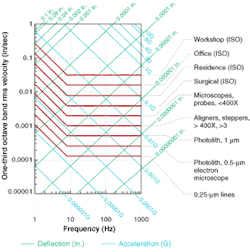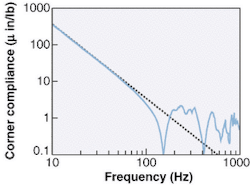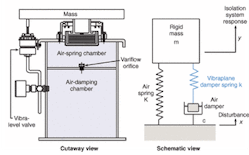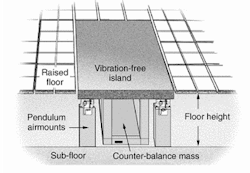HAMID SHAIDANI
All buildings vibrate, whether from machinery, heating and ventilation equipment, moving vehicles, human traffic, heavy weather, or a combination of these factors. Although usually not even noticed by people, these vibrations cannot be tolerated by many devices used in the photonics and optoelectronics industry such as microscopes and other optoelectronic devices. The newest equipment in the field is even more precise, and consequently more sensitive to vibrations.
Structural ambient vibration levels vary widely. At their worst, uncontrolled vibrations can cause excessive wear and even structural damage to sensitive optical equipment. Other problems can include excessive signal noise, low-frequency jitter, high-frequency image blur, and the appearance of line thickening. Short-term effects include inconsistent, unreliable performance and operator inefficiencies.
In many applications, accuracy concerns should go hand in hand with ergonomics. There is no point in eliminating blur and jitter from microscope work if the operator cannot stay comfortable and alert. Recent research on vibration damping and isolation has produced an array of top-quality workstations, optical tables, tabletop platforms, breadboards, mounts, and accessories that not only outperform those available just a decade ago, but also provide an extra degree of worker comfort. Many are custom-designed systems.
Allowable vibration envelopes
Various engineering committees have proposed maximum levels of root-mean-squared vibration amplitude vs. frequency—known as allowable vibration envelopes—for standardization by the International Organization for Standardization (ISO). Proposed ranges are available for types of equipment such as microscopes, probes, and electron microscopes (see Fig. 1). Designers of sensitive equipment can use these figures and seek additional expert advice about parameters such as mass and stiffness. With additional foresight, more vibration-control components could be built into the equipment itself at the point of design. This is happening in some instances, but there is a potential for a more aggressive approach.
It is ultimately the end user's responsibility to provide an efficient operating environment, however, and vibration-control-equipment manufacturers are educating users of sensitive equipment about the best methods to provide isolation for the particular application (see "The right system begins with a vibration analysis").
Controlling vibrations
Low natural frequencies (1 to 2 Hz) can be achieved by the best vibration-isolation systems. These systems attenuate all potentially damaging vibration amplitudes in the 8- to 200-Hz broadband random-vibration spectrum. Our surveys indicate that most building vibrations range within the lower half of this spectrum. And most vibrations are vertical, with horizontal vibrations averaging 25% to 30% of the vertical. Natural frequency and isolation efficiency are the two most important factors to be considered in determining the kind of isolation system needed.
Conventional vibration isolators use metal springs or rubber blocks. Because of their low internal damping, they tend to be effective only at frequencies near 10 Hz. Almost no isolation is provided at frequencies above 30 Hz because harmonic standing waves occur in the metal or rubber. New isolation equipment eliminates the springs and the blocks. These models use frictionless, rolling-diaphragm air seals (air-springs) that, in conjunction with dual air chambers, support load-carrying pistons. The air-spring stiffness is a function of the combined air volume of the dual chambers. This design provides the very low stiffness needed to obtain the desired very low natural frequency and thus high isolation efficiency. These designs prevent harmonic standing waves and, in some cases, achieve vertical and horizontal vibration isolation efficiencies of better than 95%.
A high-quality optical table will offer quad-tuned as well as broadband vibration damping using individual absorbers (tuned to the two lowest natural frequencies, bending and torsion, of each table) embedded in all four corners of the table (see Fig. 2). This is narrow-band selective damping, provided by four frequency-tuned, mass-spring resonators dry-damped and tuned to resonate 180° out out of phase with the lowest frequency of the table. The out-of-phase inertial forces induced in each resonator mass act to cancel or absorb the motion of the table at its natural frequency and lower the resonant amplification.Control solutions
Many laboratories require vibration-isolation systems that automatically level; therefore, workstations are available with auto-leveling devices, usually connected to a compressor or other pressurized air source. Using servo valves to feed air to or bleed air from each table leg, the tabletop is maintained at a preset zero-deflection level independent of load addition or removal (see Fig. 3). Modular support systems that allow retrofitting of workstations to increase their load capacity are also available. With this type of equipment, passive air springs or active isolator mounts are often dropped into each legstand for better performance.Special tables and workstations are available for use in any class of cleanroom. Class 1 models are constructed from electropolished stainless steel and welded tubular braces to minimize the amount of horizontal surface, which could collect dust or other airborne particles. They also have completely enclosed isolation modules and stainless steel valves that vent through the room's exhaust. Tabletops are available with damped electropolished stainless steel laminate construction to ease cleaning.
Variable-height workstations reduce user fatigue and back stress. These are remotely activated with a smooth, quiet electrohydraulic mechanism that allows the user to raise or lower the tabletop to maintain a posture that is ergonomically correct—a major benefit when accommodating different operators on different shifts.
Designs for precision
Although tabletops need to be supported by low-frequency isolation support systems, the tabletops themselves should have high internal natural frequencies. Tabletops (and breadboards, which lack isolation systems) can be built with honeycomb-type cores for lighter weight without sacrificing rigidity. In fact, tabletops with these interior cores of steel hexagonal cells can achieve natural frequencies higher than frequencies attainable with either ribbed cast iron or a solid granite block of the same size. Vibration-control tabletops and breadboards now incorporate the latest advances in composites and adhesive technologies combined with corrosion-resistant metals and layering techniques to provide lightweight, rigid, highly damped surfaces. To eliminate the possibility of interior corrosion as a result of a spill through the mounting holes, a spillproof section is included under the top layer to channel liquid spills away from the core where they can be drained.
Heavy-duty mounts, support systems, isolation platforms, and islands provide excellent isolation for large equipment. Platforms that isolate floor-mounted equipment from the surroundings are available for gross loads up to 25,000 lb. Vibration-free islands are typically installed on a subfloor, providing a floor-level pedestal that isolates a section of a room from vibrations in the surrounding raised flooring (see Fig. 4). Equipment mounts for custom requirements with load capacities up to 20,000 lb per mount are also available.As demands for precision and performance increase, advances in technology have produced optical equipment that is highly precise but also ultrasensitive to vibrations. These devices require very high isolation capabilities at very low frequencies (2 Hz and lower), with quick response to microdisturbances. This performance can be achieved by isolation systems that incorporate a combination of mechanical passive and electromechanical active isolation concepts.
The active components of these systems use advanced control methodologies to sense microdisturbances and provide quick and accurate actuator response for control. These systems typically have a natural frequency in the 0.5- to 1.0-Hz range and provide isolation efficiencies as high as 90% at as low as 3 Hz. The passive components handle isolation at higher frequencies at which the damping energy required is out of range of the active component.
Many accessories are available to customize workstations, including shelves, draws, armrests, and casters. Meanwhile, vibration-control scientists continue to integrate new ideas into their products.
Hamid Shaidani is director of engineering at Kinetic Systems, 20 Arboretum Rd., Boston, MA 02131; e-mail: [email protected].



